The fact that this list is composed of so much varied music made it difficult, if not impossible, to assemble in any coherent fashion. In some respects, it's a pointless exercise to balance the relative merits of records so different from one another as to be from different universes — but nor did I want to separate out different musical areas into their respective ghettos. All rankings here are approximate, then, general markers of my appreciation for a particular album. In the interests of preserving the list's variety, I've also limited each artist to a maximum of three separate entries. Scattered throughout the blurbs are quotes from reviews I wrote when these albums were new, to connect this list back to my last ten years of listening and writing about music. I hope this list does for perhaps a few people what the music I'm talking about here did for me: excited me, suggested new possibilities in sound, made me happy, moved me, shocked me, made me sit up and listen intently.
I'll be posting the list 50 entries at a time over the next few days until it is complete, with the top 50 appearing on Thursday.
200. Widnoon | Personal Mythology Is Worth Our Time
(Blue Book, 2004)
He's probably not doing it anymore, but at one point Bryan Neil Jones' "Personalized Cassette Project" was an absolutely brilliant sound art conceit: send him a few dollars, or trade one of your own recordings, and he'd make you a one-of-a-kind tape recorded just for you. On the cassette he made for me, he curses me out by name and rants about the pressures of recording, in between segments of blistering harsh noise. It's sometimes dark and ugly, sometimes kind of fun, and it's thrilling to know that it's so personal, a rare example of one-on-one communication between artist and listener rather than a mass-duplicated recording released in large numbers and sold in stores.
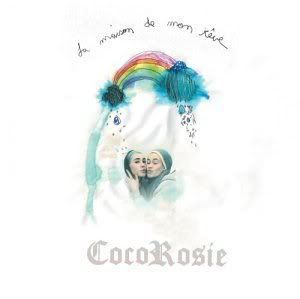 199. CocoRosie | La Maison de Mon Rêve
199. CocoRosie | La Maison de Mon Rêve(Touch and Go, 2004)
The debut album of sisters Sierra and Bianca Cassidy is an appealing, lo-fi genre blend, the eccentricities of which are most readily apparent in the contrast between the sisters' voices: the classically trained operatic soaring of Sierra set off against the bluesy bullfrog croak of Bianca. The album balances precariously on the edge of unbearable kitsch, but somehow avoids the trap despite the proliferation of beeping toy sounds, the casual appropriation of old-fashioned musical styles, and the absurdity of a pair of cosmopolitan girls singing from the point of view of a racist Christian fundamentalist, an abused housewife, or an Eastern European prostitute. Thankfully, all this role-playing is fleshed out by the band's quirky tunes, which combine blues, opera, folk, and various ethnic musics with touches of electronics and samples.
 198. Xombie | Acideater
198. Xombie | Acideater(Chondritic Sound, 2003)
This is slooooow noise. A rumbling, reverberating synthesizer line crests and wanes with mechanistic precision, fading in and then washing away, receding into the distance. Over this steady backdrop, squeals and whines pierce the cyclical tranquility. It's eerie music, haunted house music, music that makes a fitting accompaniment to the tinted skulls on its cover.
 197. RJD2 | Deadringer
197. RJD2 | Deadringer(Def Jux, 2002)
Hip-hop producer RJD2's debut is packed with crackling vinyl samples and killer beats ripped straight from the DJ's no doubt tremendous record collection. It's awash in vinyl atmosphere, in the gritty feel of the best sample-driven hip-hop; not since DJ Shadow's prime has there been a better trawler of record bin samples. He blends genres ably, layering funk, soul, 60s garage rock, surf rock, goofy novelty hits, all these voices and sounds jutting up against each other, creating fruitful collisions of eras and voices that seem to be in conversation within the context of RJD2's music.
 196. Sir Richard Bishop | While My Guitar Violently Bleeds
196. Sir Richard Bishop | While My Guitar Violently Bleeds(Locust Music, 2007)
The Sun City Girls' Richard Bishop goes solo for this album of meandering guitar pieces, bookended by a visit to John Faheyland (all delicate, fast-paced folksy plucking) at one end and a lengthy Indian raga-influenced piece at the other end. A vicious feedback scrawl anchors the album in the middle, with what sounds like ghostly voices howling through the smoky fog of the guitar drone.
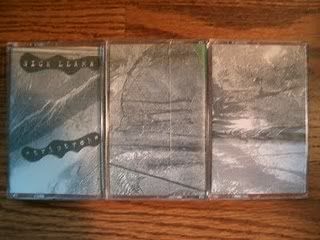 195. Sick Llama | Triptych
195. Sick Llama | Triptych(Fag Tapes, 2008)
This grimy and reedy three-tape set is a great example of Sick Llama's filthy-sounding noise. It's rough and thin, like a narrowly focused laser, low rumbling topped by pure high tones, everything sounding washed-out and faded. It's deeply worn music, the sound of a last desperate attempt at communication from within an endless abyss, these last faint and hopeless sounds the only traces to make it to the surface from within those dark depths.
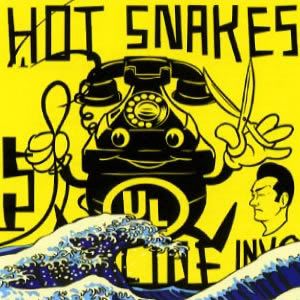 194. Hot Snakes | Suicide Invoice
194. Hot Snakes | Suicide Invoice(Swami, 2002)
Loud, fast, and unrelentingly aggressive, Hot Snakes' second album is a compact burst of garage punk fun, with one great rock tune after another. The lyrics obliquely namecheck the Stooges' "Down in the Streets," and the lineage is obvious, the reference well-earned by the band's rock maelstrom. Rick Froberg's confrontational vocals are front and center, spitting out nasty phrases about death and loss, while the tight band functions like a perfect punk machine behind him.
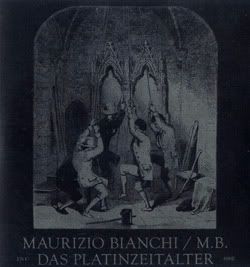 193. Maurizio Bianchi | Das Platinzeitalter
193. Maurizio Bianchi | Das Platinzeitalter(Incunabulum, 2007)
Maurizio Bianchi was a legend of the 1980s international industrial/noise scene, unleashing several landmarks of bleak, desolate ambiance before disappearing into silence altogether. He's re-emerged of late, and this album recaptures the ominous soundscapes of his 80s classics. It's ritualistic music, built around slow-moving loops and gradually unfurling waves of sound; it's resolutely abstract but is apparently sourced largely from classical lute recordings, which perhaps explains the hint of nearly religious fervor that takes over the music from time to time.
 192. various artists | Mulholland Dr. soundtrack
192. various artists | Mulholland Dr. soundtrack(Milan, 2001)
David Lynch's feel for music is almost always impeccable, and it's at its peak in Mulholland Dr., his finest film and his most musically evocative. Here, 60s pop (like Linda Scott's irresistible version of "I've Told Ev'ry Little Star") collides with the dark soundscapes of composer Angelo Badalamenti, Rebekah Del Rio's jaw-dropping Spanish take on Roy Orbison's "Crying," twangy surf rock, stomping blues, and some of Lynch's own warped rock music. Listening to the album is nearly as atmospheric and affecting as watching the film itself, making it an essential companion piece to a masterful film.
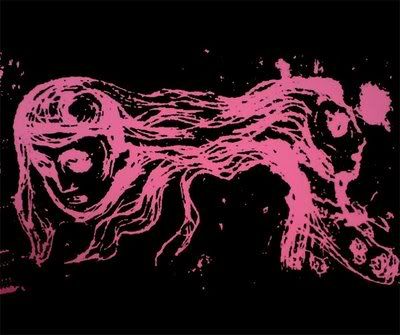 191. The Goslings | Grandeur of Hair
191. The Goslings | Grandeur of Hair(aRCHIVE, 2006)
The Goslings aren't so much a metal band as a band that uses the signifiers of metal to build big fluffy clouds of sound constructed from pile-ups of grinding guitars, bassy rumbling and trashcan percussion. Their sound is so all-encompassing that the individual instruments are swallowed up by the swampy drone. Occasional moments of clarity shine through, though, strangely beautiful in this grimy context, like the lilting melody, carved out of feedback, that winds its way through the murk of "Overnight."
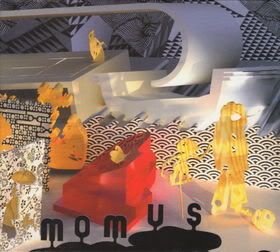 190. Momus | Oskar Tennis Champion
190. Momus | Oskar Tennis Champion(American Patchwork, 2003)
My feelings about this goofy album of perverted electro-pop are best summed up through my exegesis of its best song, "Pierre Lunaire," which I've called "a dark, demented meditation on obsession cased in sheeny synths and vibrating turntable scratches. Momus dispassionately intones about a male object-of-lust, culminating in the deadpan chorus 'I'll set myself on fire/ pour petrol in my hair/ as if he'd even notice/ as if he'd even care/ I'm so in love with Pierre Lunaire.' Around his voice, faux-strings and carnival keyboards chart Old World melodies while clattering percussion and a never-ending array of unidentifiable sounds swirl amid the controlled chaos. It all breaks down at the end for a low-budget hip-hop coda where Momus whisper-raps over junkyard beats."
 189. Mogwai | Rock Action
189. Mogwai | Rock Action(Matador, 2001)
There's something very elegant and graceful about this Mogwai album, on which the Scottish post-rock troupe turn from epic guitar overload to warm, glistening melodies with wordless vocals sporadically drifting through these plaintive, slow-building songs. Each piece here seems to be gradually ascending, which befits the vague spiritual aura that newly inflects the band's music, suggesting a trying climb to paradise through the haze of the guitars and synths.
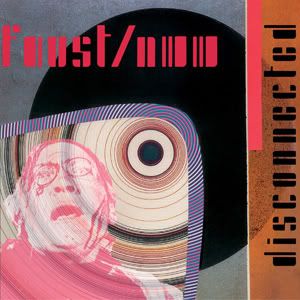 188. Faust/Nurse With Wound | Disconnected
188. Faust/Nurse With Wound | Disconnected(Art-errorist, 2007)
Krautrock trailblazers Faust are still chugging along in the 2000s, but remarkably they've managed to maintain at least some of the edge that made them one of the most original bands of their era throughout the 70s. Most of that edge can be seen these days in their unexpected collaborations: a not-quite-successful pairing with avant hip-hop outfit Dälek, and a thrillingly adventurous collab with British industrial legend Steven Stapleton of Nurse With Wound. Disconnected manages to map out exciting sonic territory somewhere between the steamroller rhythms of classic Faust and the warped electronics of NWW. Stapleton seems to win out towards the middle of the album, which is all droney textures filled out with drum-circle rhythms and glistening feedback waves, but Faust saves up their big explosion for the end, a rocking live performance that quotes Bob Dylan and recaptures the righteous outrage of the protest era.
 187. Sunroof! | Cloudz
187. Sunroof! | Cloudz(VHF, 2003)
Yet another drone/rock project from Matthew Bower of Skullflower and Total, who seems to get tired of his aliases every few years. Ranging from looped ambient electronics to noisy guitar freakouts, Cloudz melds together Krautrock's motorik pulse, fuzzy psychedelia, and noisy outbursts into a coherent whole. It is a hazy sort of album, with its melodies and structures often encrusted in layers of feedback and hiss.
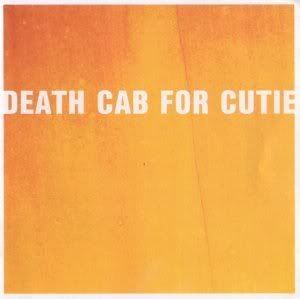 186. Death Cab For Cutie | The Photo Album
186. Death Cab For Cutie | The Photo Album(Barsuk, 2001)
On this indie-pop band's best album, they smooth out some of the rougher edges of their first few discs, but hardly sacrifice their passion, as singer Ben Gibbard croons angrily about the moral bankruptcy of Los Angeles and finds that even a deadbeat father's death can't extinguish a son's virulent hatred. It's an emotional album on which these strong feelings are harnessed by some of the band's warmest, poppiest tunes.
 185. Björk | Volta
185. Björk | Volta(Atlantic, 2007)
Yet another eccentric, inventive album from Björk shouldn't be a surprise at this point; she's so consistently enjoyable in her inimitable weird way that it's easy to take her for granted. Volta is the most aggressive and ebullient album the Icelandic singer has done in over a decade, largely jettisoning the darker electronic textures of more recent work for bold brass arrangements, furious beats inspired in equal parts by tribal rhythms and drum-n-bass, and generally unrestrained, over-emoting vocals. It's also a very communitarian album, despite its strong central presence, pulling in contributions from hip-hop producer Timbaland, the singer Antony (whose instantly recognizable voice provides a very distinctive counterpoint to Björk on two traditionally structured duets) and avant-rock drummers Chris Corsano and Brian Chippendale.
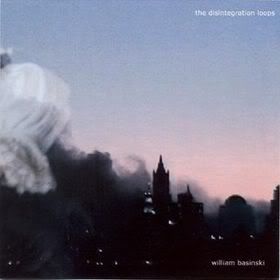 184. William Basinski | The Disintegration Loops
184. William Basinski | The Disintegration Loops(2062, 2002)
In September 2001, William Basinski was transferring some old tape loops to digital backups on the roof of his Brooklyn flat, admiring and lamenting the way the loops' decaying quality led to an eerie, melancholy vibe: the music was disappearing even as he transferred it from these old tapes. The resulting four discs of delicate ambient tones acquire additional resonance from the fact that as Basinski was making these pieces, he watched the planes crash into the World Trade Center. These pieces are thus inseparable, in their wordless sadness and nostalgia for a lost world, from the circumstances of their creation.
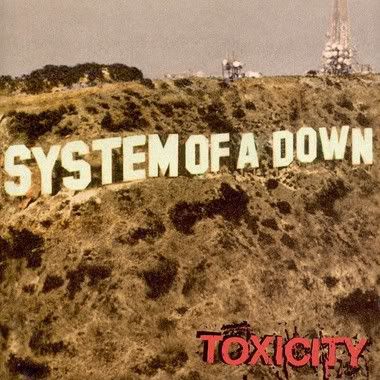 183. System of a Down | Toxicity
183. System of a Down | Toxicity(American, 2001)
These Armenian-American rockers are at their peak on their sophomore album, a frenetic metal masterpiece on which Serj Tankian's spasmodic vocals bounce off of the music's hard corners and stop-on-a-dime transitions from bouncy punk to blistering metal to bizarro interludes inspired by Armenian folk. This eclecticism prevents Toxicity from ever settling down or growing as boring as most mainstream rock. Instead, Tankian is hectoring and strident on the political rants of "Prison Song" and "Jet Pilot," playful on "Bounce," alternately mournful and enraged on ubiquitous single "Chop Suey!," and downright tuneful on "Aerials." The album's all over the place but never seems schizophrenic; it's all held together by the band's undeniable metal chops and their ability to make jaw-dropping stylistic shifts seem utterly natural, as though these Eastern European melodies were made to coexist with over-the-top metal mania.
 182. Mammal | Lonesome Drifter
182. Mammal | Lonesome Drifter(Animal Disguise, 2007)
Mammal's Lonesome Drifter might not be the noise album one would expect from this Detroit act's history — instead it's all curdled Black Sabbath riffs, broken-down drum machines and the world-weary deadpan drawl of Gary Beauvais — but it has the spirit of noise. Its industrial-metal wasteland is stark and minimalist, cleared of life, a flat space left in the aftermath of some calamity, and Beauvais stakes out this flattened territory with singleminded intensity.
 181. Caribou | Andorra
181. Caribou | Andorra(Merge, 2007)
Electronic artist Dan Snaith's fourth album (and second as Caribou, after a name change from Manitoba) rarely betrays its status as a one-man electronic recording project. Instead, this warm, summery album is awash in joyous 60s pop vibrance, meticulously assembled by Snaith, who plays all the instruments and sings in a high, gentle voice that drifts through his dense productions. The music encompasses Beach Boys-style summertime music alongside hints of Snaith's earlier fascination with gauzy shoegazer feedback clouds and an appreciation for the warped psychedelia of early Pink Floyd. It's lush, overripe music, with Snaith's electronic processing mixing these nostalgic influences into a thoroughly modern context.
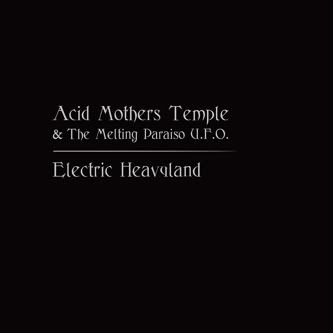 180. Acid Mothers Temple & the Melting Paraiso U.F.O. | Electric Heavyland
180. Acid Mothers Temple & the Melting Paraiso U.F.O. | Electric Heavyland(Alien8, 2002)
This is rock that seems to have been recorded in a haunted graveyard, late at night, while UFOs are landing in the background. Three lengthy, loud-as-hell tracks, with spacey electronics and spectral howls twirling around the stereo field as the guitars, ignoring the chaos, simply shred. This is the Japanese psych collective's most rockin' album.
 179. Knives | complete discography
179. Knives | complete discography(Swampland/Troniks/self-released, 2005)
The entire recorded output of noise duo Knives (The Cherry Point's Phil Blankenship and Pedestrian Deposit's Jon Borges) adds up to roughly a half hour of music, spread out across a pair of short tapes (Empty Desire and Cemetery Girls) and a 7" (Switchblade Princess). So it seems appropriate to consider their whole discography as one unified statement, a blistering assault densely packed with roiling waves of static and intense, crackling sheets of noise.
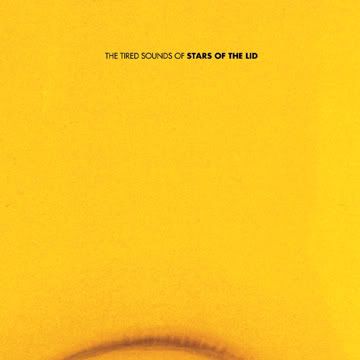 178. Stars of the Lid | The Tired Sounds of...
178. Stars of the Lid | The Tired Sounds of...(Kranky, 2001)
This is a monumental double LP of blissful ambient drone, quiet and intensely low-key, music to get lost in for hours at a time. Its gentle atmospherics creep into the brain, slowly and subconsciously, infusing the listener with its peaceful aura, quietly insisting on the subtleties lurking within its seemingly amorphous surfaces.
 177. Okkervil River | Black Sheep Boy
177. Okkervil River | Black Sheep Boy(Jagjaguwar, 2005)
Taking as their starting point a song by 60s folkie Tim Hardin, Okkervil River build an emotionally affecting concept album based around the lonely young man from Hardin's song (a quiet cover of which opens the album). Will Sheff's passionate voice, always straining against each word, imbuing his twisty lyrics with deeply felt meanings, defines the rage and desperation of this sad character. The music matches the yearning in Sheff's voice, with dynamics that leap from mournful cello to outbursts of raging rock, stopping along the way for another Hardin cover, this one a surreal bit of melancholy romanticism sung from the point of view of a rock.
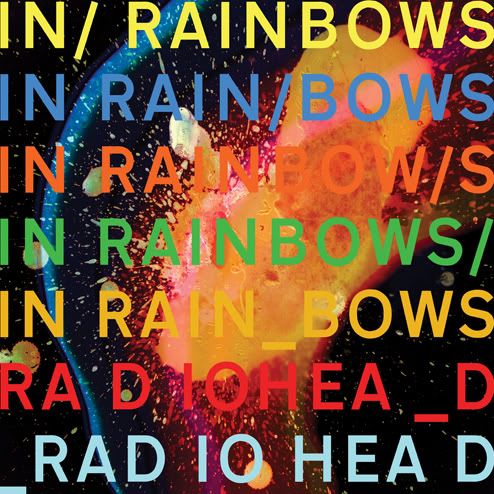 176. Radiohead | In Rainbows
176. Radiohead | In Rainbows(TBD, 2007)
In Rainbows has sadly gotten more attention for its method of distribution — Radiohead's experiment in circumventing record labels — than for its music. Actually, it's a fine album, an honest-to-goodness "mature" statement from a band that has been through its straightforward rock god phase, and its restless experimental phase, and come out the other side dedicated to putting it all together. This album might lack the energy or daring of earlier Radiohead milestones, but it's packed with smart, subtle songs where Thom Yorke's mournful voice soars above folksy strumming ("House of Cards"), IDM glitch-beats ("15 Step"), and stripped-down beds of percussion ("Reckoner"). It's a compendium of what has made this band so special, as well as a disarmingly warm album from a band that otherwise hasn't been quite so direct or accessible in years.
 175. Califone | Roots and Crowns
175. Califone | Roots and Crowns(Thrill Jockey, 2006)
The rootsy desolation of Califone is married to restless eclecticism. They insist on diverting from a plaintive folk ballad into a meandering, near-abstract interlude, or bolstering Tim Rutili's croaking moan with a backdrop of clattering percussion that unexpectedly coalesces into a pseudo-hip-hop beat. It's surprises like this that make Roots and Crowns such an engaging, enjoyable blend, with the hard edges of various genres — the twang of a folk guitar, the trash-can percussion, the occasional industrial rhythms, the hints of melancholy horns in the background — jutting up against each other to create a whole that's as spiky as a cactus.
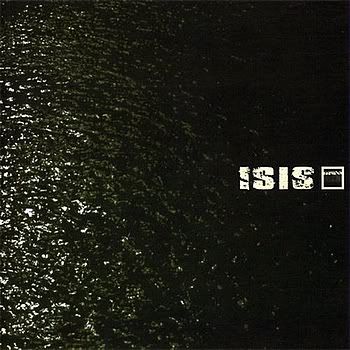 174. Isis | Oceanic
174. Isis | Oceanic(Ipecac, 2002)
This epic album incorporates crushing metal emotionality with sections of spacey atmospherics, blending Isis' metal roots with the dynamics of post-rock. The result is subtly affecting, as much for its mournfully quiet stretches as for the less frequent metal outbursts. Its darkness and anger have been made, somehow, beautiful and elegant.
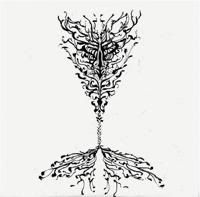 173. The Cherry Point/John Wiese | Pyramid Suites, Vol. 2
173. The Cherry Point/John Wiese | Pyramid Suites, Vol. 2(Troniks, 2004)
A split 7" between the wildly prolific Wiese (of Bastard Noise fame) and Troniks founder Phil Blankenship's Cherry Point. It's a compact encapsulation of everything that's best about both artists. Here's what I had to say in 2004: "Cherry Point’s side: five minutes of the most engaging harsh noise imaginable. It's rough, raw, and dynamic without being random or jumpy. Wiese's side, on the other hand, is... fast knife-cuts of noise followed by quick splices of beeps, radio static, and distorted rhythms, interspersed with momentary pauses that give the whole thing a strobe flicker effect. Two different approaches, both equally compelling."
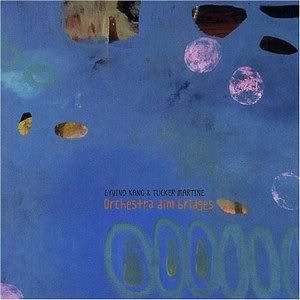 172. Eyvind Kang/Tucker Martine | Orchestra Dim Bridges
172. Eyvind Kang/Tucker Martine | Orchestra Dim Bridges(Conduit, 2004)
This collaboration between two avant-garde musicians who have each worked in a multitude of different styles and contexts is surprisingly melodic and fluid. The music incorporates ambient burbling, repetitive piano motifs, clattering percussion, and melodies that waft through these drifting compositions like a light breeze. It's all swaddled in a hazy production style that makes the music seem slightly out of focus, somehow eerie and mysterious with Kang's violin weaving through the skittering drums and sensuous electronic soundscapes.
 171. The Blood Brothers | ...Burn, Piano Island, Burn
171. The Blood Brothers | ...Burn, Piano Island, Burn(V2, 2003)
The Blood Brothers' third album is spectacularly tight and focused, and yet it still somehow gives the impression of messily spasming towards emotional catharsis. The band presents a cacophony of competing vocals (by dueling singers Johnny Whitney and Jordan Billie), leaping from screechy screams to heartfelt but out-of-tune stabs at melodicism to belting out drunk punk singalongs. This punk Babel is matched in the raw energy of the music, in which the galloping drums propel the guitars to ever greater heights of frantic excess.
 170. Sun Kil Moon | April
170. Sun Kil Moon | April(Caldo Verde, 2008)
Mark Kozelek's third album with the moniker Sun Kil Moon, his post-Red House Painters project, contains some of the singer's most mournful and delicate music. April's opener, "Lost Verses," meanders across nine and a half minutes of a plodding beat, careful acoustic strumming, and of course Kozelek's emotionally heartfelt vocals, before a momentary electric catharsis at the climax. This provides the template for this whispery album, where Kozelek's gentle music is only occasionally stirred up by the intrusion of his blustery electric guitar.
 169. Arcade Fire | Funeral
169. Arcade Fire | Funeral(Merge, 2004)
Arcade Fire's debut album is one of those albums where you can just feel a talented young band synthesizing all their influences (Television, post-punk, Radiohead, various contemporary indie bands, and so on) into a coherent and very personal statement of their own. Dramatic and overtly emotional, informed by the loss of close family members, the band's music surges and seethes, as Win Butler's expressive voice relates stories of heartache, mortality and nostalgia. It's a rich work, stuffed to capacity with vitality and beauty.
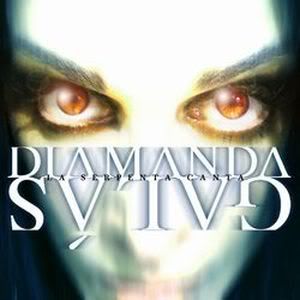 168. Diamanda Galás | La Serpenta Canta
168. Diamanda Galás | La Serpenta Canta(Mute, 2003)
Nobody does harrowing like Diamanda Galás, with her chilling, octave-leaping voice and obsession with dark material. On this album, accompanying herself at times violently and abrasively on the piano at a series of live shows, she performs mostly covers of folk, blues and jazz standards, making them her own simply by bending their tunes, and their emotions, into the unconventional shape of her astounding voice. That voice — cracking, crooning, shifting registers, howling, crying, gasping over words — is all the instrument she needs, as she breathes energy and intensity into these familiar classics. Her unrestrained treatments of songs like "Ain't No Grave Can Hold My Body Down" bring out all the mortal terror embedded in these songs of death and desolation.
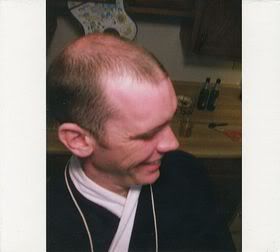 167. Graham Lambkin | Salmon Run
167. Graham Lambkin | Salmon Run(Kye, 2007)
This is a really odd congruence of classical music samples, haunted house atmospherics, and electronic noise. Lambkin's field recordings merge with operatic arias and gorgeous string movements, giving the impression of this old music being pumped into a particularly rich sonic environment: bird calls, creaking floorboards, unhinged laughter, humming, tinkling chimes, eerie drones and processed snorting noises. It's all so weird, so off-kilter, and it keeps the listener unbalanced as well, unsure of what's coming, unsure of how these disparate sounds — can there be any greater gulf than that between classical music and pig noises? — can coexist within the same space.
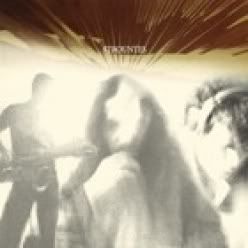 166. Strountes | s/t
166. Strountes | s/t(Slottet, 2006)
It's hard to think of a more counterintuitive trio than the union of Anla Courtis (of Argentine psych-rock outfit Reynols), free jazz saxophonist Mats Gustafsson and Swedish bubblegum pop vocalist Maria Eriksson. This unlikely trio make some very warped music, with Eriksson's murmured sweet nothings and hummed melodies dancing atop folksy acoustic guitar, crunchy feedback and electronics, and the blurting, squealing tones of Gustafsson's sax, which often seems to be emanating from another space altogether. The music holds together, surprisingly, and the tension between these seemingly irreconcilable elements adds to its odd appeal.
 165. Brian Wilson | SMiLE
165. Brian Wilson | SMiLE(Nonesuch, 2004)
There was never any question of Brian Wilson today finally finishing SMiLE just the way he might have back in the 60s. But if you ignore the album's status as the great lost legend of the psychedelic era, an album many believe might've been one of the best ever if it'd actually been completed, his new take on SMiLE is an endearing, satisfying recording in itself. It's the work of a man now old enough to look back on all the drama and legend surrounding this record with a faint nostalgic glow, and deliver a charming, poppy, slightly silly take on all the old tunes he never got to polish up just so.
 164. The Fiery Furnaces | I'm Going Away
164. The Fiery Furnaces | I'm Going Away(Thrill Jockey, 2009)
On the Fiery Furnaces' eighth album — and their best since Blueberry Boat — the core sibling duo of Matthew and Eleanor Friedberger tame their sound somewhat, trading in restless prog structures and spiky dissonance for a set of comparatively straightforward modern blues tunes. They're still prone to melodramatic vocals and songs built around chains of stylistic detours, but by toning down their more overtly weird moments, they haven't sacrificed any of their unique charms. Instead, these pop R&B tunes channel the duo's emotional catharsis into tight, accessible melodies and complex but no longer schizophrenic arrangements.
 163. Sudden Infant | Invocation of the Aural Slave Gods
163. Sudden Infant | Invocation of the Aural Slave Gods(Blossoming Noise, 2005)
Longtime Austrian noise provocateur Joke Lanz is here joined by collaborator Annie Stubbs for a weird mashup of harsh noise, pounding industrial-metal, performance art theatrics and other oddball bits and pieces. The duo transform the Damned's "Nag Nag Nag" into a nutty industrial stomper, with sound effects flying crazily through the chunky noise maelstrom. They close the album out with another cover, turning Roxy Music's "In Every Dream Home a Heartache" into a creepy, creaky ballad with Stubbs' deadpan vocals drifting through a distorting echo chamber. The rest of the album careens unpredictably between various modes, from Lanz's repertoire of gagging and retching noises to Stubbs' cymbal crashes to the noisy outbursts where it's impossible to figure out exactly what is going on. It's chaotic, and often kind of goofy and kind of terrifying all at once.
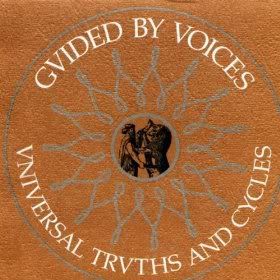 162. Guided By Voices | Universal Truths and Cycles
162. Guided By Voices | Universal Truths and Cycles(Matador, 2002)
Robert Pollard's long-running indie mainstays developed over time from ragged lo-fi garage rockers into something slightly less ragged, so by the time of this 2002 album, the rough edges are mostly gone, but not Pollard's prolific songwriting chops. Pollard has an instinctive feel for hooks, whether he was tossing them off left and right on earlier discs or crafting somewhat more solid song structures around them here. Highlights like "Everywhere With Helicopter," "Christian Animation Torch Carriers" and "Back to the Lake" are bouncy and rocking, the kind of energetic, melodic rockers that easily worm their way into listeners' skulls and linger there for good.
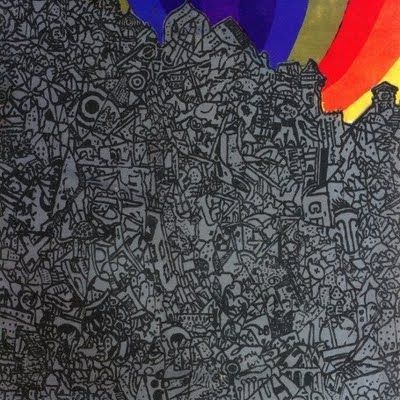 161. Lightning Bolt | Wonderful Rainbow
161. Lightning Bolt | Wonderful Rainbow(Load, 2003)
Somewhere within the churning, tumultuous depths of this album is the soul of a prog rock band: the combination of Brian Chippendale's fast-paced, pounding drums with Brian Gibson's raw, blown-out bass creates a kind of noisy virtuosity within the seeming chaos. This is vigorous, relentless music, with Chippendale's drums frantically struggling against the tidal pull of Gibson's bass, which throws out depth charge pulsations and ugly scrawls of noise. On the other hand, the bass creates a bed of squiggly arpeggios on "Crown of Storms," counterpoint to Chippendale's head-banging beat and blurry vocals, while "Longstockings" builds its particular form of chaos from a surprisingly melodic foundation.
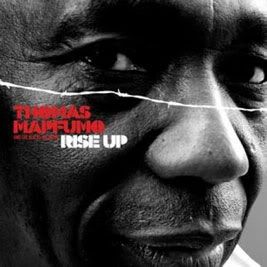 160. Thomas Mapfumo and the Blacks Unlimited | Rise Up
160. Thomas Mapfumo and the Blacks Unlimited | Rise Up(Real World, 2006)
Zimbabwean musician Thomas Mapfumo has been exiled from his homeland since the 1990s, when his political commentary on President Robert Mugabe made it impossible to live in the place where his musical style, and his political consciousness, had been born and nurtured. Based in the US now, his music retains its easy-going appeal; Mapfumo virtually invented his own style, called chimurenga, which is based on traditional mbira music and other African styles, as well as jazz, rock and electronic music. It's lively and poppy music, infectious and light, with Mapfumo's smooth voice often joined by layered background harmonies as the music shifts from slow grooves to bouncy percussive sections.
 159. Circulatory System | s/t
159. Circulatory System | s/t(Cloud, 2001)
Following the breakup of psych-pop outfit The Olivia Tremor Control, Will Cullen Hart immediately moved on to Circulatory System, which basically continues OTC's legacy with little alteration. Meaning, the band's self-titled debut offers up melodic psychedelia, with a lo-fi production sound that's perfectly suited to the band's gauzy melodies, bursts of singalong roughness, and careful balance between exuberance and mournfulness. The clear standout is a poppy gem called "Joy" — which lives up to its title not with outright bombast but a more subtle world-wise optimism in the face of disappointment — but the whole album is packed with compact little charmers like this.
 158. Olivia Block | Heave To
158. Olivia Block | Heave To(Sedimental, 2006)
Olivia Block's warm, slow-moving electroacoustic drone is built from the contributions of a small orchestra of collaborators, 10 instrumentalists who join Block's scraping cello with various horns and strings. The resulting music is dense and deep, creating sizzling soundscapes in which individual voices only occasionally rise above the overall drift.
 157. Burning Airlines | Identikit
157. Burning Airlines | Identikit(DeSoto, 2001)
The second album from these D.C. hardcore alums, led by Jawbox vocalist J. Robbins. This disc expands upon the melodic hardcore of its antecedents and of the first Burning Airlines full-length, building literate, complex music on a pop-punk foundation. The whole album consistently delivers on the band's promise of smart, fun rock, but it especially has a near-flawless first half, ranging from the energetic opening burst of "Outside the Aviary" to the shifting rhythms of "Morricone Dancehall" to the moody storytelling of "The Surgeon's House."
 156. Panda Bear | Person Pitch
156. Panda Bear | Person Pitch(Paw Tracks, 2007)
The Beach Boys get pulled apart and stretched out like taffy, as this Animal Collective singer's melodies lope amiably atop a bed of shambling percussion and chiming guitar tones. It's as playful and layered as anything coming from this collective, a shimmery summertime album with joy and pleasure bursting from every vocal fragment, every looped rhythm.
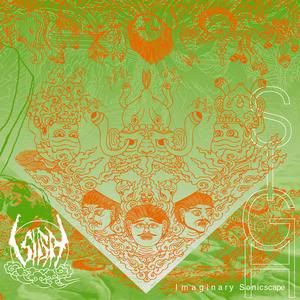 155. Sigh | Imaginary Sonicscape
155. Sigh | Imaginary Sonicscape(Century Media, 2001)
You know what makes Japanese metalheads Sigh such an awesome band? It's the combination of growly death metal vocals with goofy, synth-heavy melodic power metal. And, oh yeah, the lite jazz piano noodling. And the cheesy disco hooks. And, especially, the sense that the band is equally earnest about their intense metal mythologizing ("I am the sun, I am the moon/ born in Heaven and raised in Hell") and their loony, exuberant mashups of death/black metal with hilariously inappropriate genres like 80s synth-pop and glam rock.
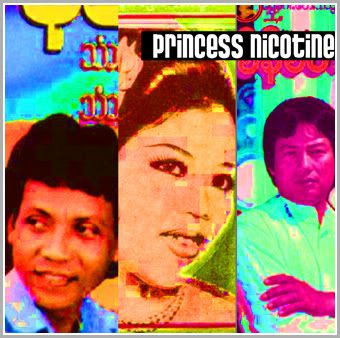 154. various artists | Princess Nicotine: Folk and Pop Music of Myanmar (Burma) Vol. 1
154. various artists | Princess Nicotine: Folk and Pop Music of Myanmar (Burma) Vol. 1(Sublime Frequencies, 2004)
Compiled by Alan Bishop of the Sun City Girls, this collection gathers together a small selection of skewed pop gems from Burma, rough and ragged music taken from the cheap tapes that flood that country. There are nods to Western garage rock (Mar Mar Aye's stirring "Someday He Will Return"), delicate acoustic folk tunes, and jazzy ballads, but the obvious highlights are all the exuberant songs that blend Eastern traditional music with pop forms. The best of these is the closer, Ni Ni Win Shwe's "My Darling's Love Arrow," which epitomizes this musical pastiche: thin, metallic-sounding percussion; the jangling rhythms of the gamelan; screechy intrusions of violin and horns; and a lovely voice hovering above the dissonance, pulling it all together into a tight, affecting pop song.
 153. Valerio Cosi | And the Spiritual Committee
153. Valerio Cosi | And the Spiritual Committee(Foxglove, 2007)
And the Spiritual Committee is only one of the seemingly inexhaustible stream of releases that young Italian musician Valerio Cosi has unleashed in recent years, but it's a great summation of his prodigious range. The album opens with a brief, noisy drone that builds to a violent crescendo, but Cosi then takes an immediate left turn into the propulsive electro-Krautrock of "Hoboland," which itself unexpectedly incorporates a processed sax solo towards the end. There's more straight-up jazz, albeit with a moody ambient undercurrent, on "A Burning OM," and a psych-folk jam session on "Evening Over the Hill," which starts off all noodly and easygoing and then tosses off a brilliant shift into aggressive garage riffage. Cosi's all about such juxtapositions and stylistic 180s, but the remarkable thing is that he's not some shallow genre-jumper; he manages to infuse each idiom with his own obvious enthusiasm and musical virtuosity.
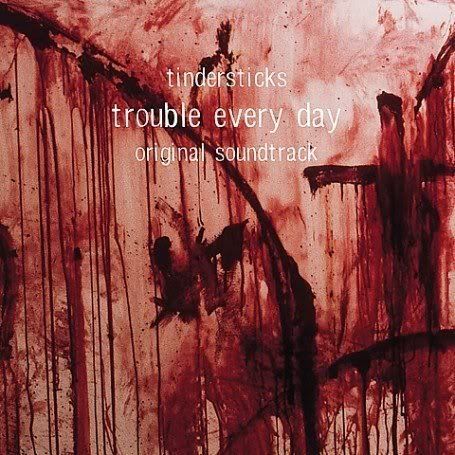 152. Tindersticks | Trouble Every Day soundtrack
152. Tindersticks | Trouble Every Day soundtrack(Beggar's Banquet, 2001)
British orchestral rock band Tindersticks has collaborated several times with French director Claire Denis, but never more successfully than on their haunting soundtrack for Denis' blood-soaked tale of sexualized cannibalism. The band returns again and again to subtle variations on the same motifs, stringing out eerie violin drones, muted horns and plucked, minimal guitar tones through these low-key instrumental pieces. It all culminates with the title track, on which Stuart Staples' expressive baritone vocals finally make an appearance to solidify the emotional impact of both the film and the album.
 151. Boris | Pink
151. Boris | Pink(Southern Lord, 2005)
Boris' Pink is a compact rock primer from a metal band that excels at transmuting their pure rock attitude into various forms: the epic grandeur of opener "Farewell," the thrashy punk messiness of "Nothing Special," the doom-laden crawl of "Blackout." It's visceral, try-anything-once metal, with the grimy guitars leading the band with equal aplomb through psych freakouts and manic punk/metal bangers.
The other entries are here:
200-151 | 150-101 | 100-51 | 50-1
This is really a fantastic project here, Ed. It seems like you are going to be single-handedly responsible for filling up my music queue for the forseeable future, as there are many promising titles in this series of 50 I've not yet heard of, and obviously many more to come. Though I haven't listened to as much as I'd like this past decade, there are quite a few here I have heard of course, and many if not all of them I really like or love. Some brief thoughts:
ReplyDeleteLove seeing the Mulholland Drive soundtrack, if only for Llorando, which is staggeringly heartbreaking.
The Disintegration Loops series would place significantly higher on my own list, these being my favorite releases from Basinski behind only The River. They're somber, heartbreaking and imporant recordings, and you are of course right that the Loops are inexorably tied to the context they were captured in; profoundly devastating stuff.
Kudos for including Stars of the Lid, who are my favorite drone act right now in the world. This album is wonderful, with their masterpiece in my eyes being ...and Their Refinement...
The more I listen to In Rainbows, the closer I come to thinking it's their greatest yet. It's at least in the conversation, and would be quite high on my list.
Person Pitch, Circulatory System s/t, Funeral, Roots & Crowns and Trouble Every Day ost have all gotten regular play from me and are all excellent inclusions. Curious to see which Animal Collective albums (if any) you have on here.
I'm thinking of drawing up my own top 25 or 50 list (since I haven't gotten around to one yet), if I do I'll post it here in the comments for your final 50. Again, wonderful job here, Ed. Can't wait to catch up with some of these, and I of course look forward to the rest of the list.
I'm always behind the times when it comes to music, so I'm a bit hesitant to make my own list. I'm glad to see stuff like Funeral and Person Pitch, though a bit surprised to see them here at the beginning. Then again, I don't run an indie label and I'd never even heard of Animal Collective until MPP came out last year and I feel in love. I feel like a list I'd make would basically be, "Hey, Modest Mouse and The National are great...We'll be right back after these messages."
ReplyDeleteThanks, Drew, glad you're enjoying the list so far, and it sounds like we share some favorites. I have to say, I was surprised how much I enjoyed In Rainbows. I was underwhelmed by Hail to the Thief and thought maybe I'd lost interest in Radiohead, but that's a damn good album, not flashy or showy, just a solid rock album with a great deal of feeling behind it. I can't say it's their best by any means, but it definitely deserves to be mentioned with their other classics.
ReplyDeleteI haven't heard anything by either Basinski or Stars of the Lid besides the albums included on this list, but when I'm in the mood for ambient/drone, those are among the major albums I'll reach for, along with Coil's Time Machines. I'll have to check out the other albums you mention.
Jake, Person Pitch is probably only so low in comparison to the rest of AC's catalog; they're a favorite band of mine and have been for a long time now. I was first blown away back when Here Comes the Indian came out; their earlier stuff was pretty good but that one was a huge step forward, and virtually everything they've done since has impressed me to varying degrees. Funeral is an album I obviously like a lot, but not to the extent that other people have hyped it up. It's good, but some people have ranked it in the top few albums of the decade, to which I can only say, "really?"
wow, i'm somewhat baffled that you picked björk's volta.
ReplyDeleteit has been the very first record from her that dissapointed me and i can't get into at all.
i found it very flat and incoherent, composition/lyrical wise. the whole thing sounded to me, like she became her own cliche, so it's pretty interesting to read your point of view. should give it a try again ;)
Anon: I could see why Volta would be tough to get into, it has a messy and chaotic sensibility that might be offputting, especially in comparison to Bjork's other albums. It's certainly not my favorite by her, or even my favorite from this decade. But for me it's just such a fun, joyous album, and it's great to hear her really cut loose like this.
ReplyDeleteI wonder if Blueberry Boat will be in the top 100? Hmm.
ReplyDeleteGreat fucking list, though! Well done. Lots of albums I haven't even heard of, never-mind checked out. Thanks!
ReplyDeleteNice list, Ed. I've only listened to a handful of these albums, so I'll be keeping this on file for future use when I'm ready for new music.
ReplyDeleteAs for the stuff I have heard:
Death Cab for Cutie -- You're spot-on that they never really recaptured what they did on that album. It's the perfect album that teeters between sugary-sweet pop tunes and acidic lyrics. Especially (as you point out) "Styrofoam Plates" which is the perfect example of why the juxtaposition of Gibbard's voice with the edge of his lyrics was one of the things that made Death Cab so appealing before they became rather dull.
Isis -- Wow. That takes me back. I might have to dust that baby off and give it a listen again.
Blood Brothers -- I agree that "Burn Piano Island Burn" is a great album, but I can only hope that some of their later stuff shows up on this list because that's when they truly came into their own as THE leaders of the post-"whatever" movement. "Crimes" is almost a masterpiece, but "Young Machetes" is an album of sheer brilliance that never relents. That being said, this choice is a good one because it shows the beginning stages of what the band was capable of with their insane (or inane) lyrics, bizarre dueling vocalists, and unpredictable timings and beats...all mashed-up to the tune of post-hardcore/punk rock that gave their sound something raw, yet clearly well thought out.
I haven't tried Guided by Voices yet...but I hear good things. I'll give 'em a shot.
Looking forward to the rest of the entries. Great stuff!
Thanks, Spencer. And yeah, I kinda gave that away with my I'm Going Away blurb, huh? There might be a few clues like that here and there...
ReplyDeleteKevin, glad you're digging the list so far. Totally agreed about later Death Cab, which really is mostly dull, with all the best bits sanded away. I have to admit I haven't gotten around to later Blood Brothers yet, but considering my appreciation for Piano Island I've always meant to. Good to hear they get even better!
When you do check out GBV, I'd highly recommend starting with an earlier classic like Bee Thousand, which is really their definitive work. Robert Pollard has this knack for tossing off brilliant tunes left and right like he barely cares about them, which means that his best albums are these loose collections of stray hooks barely knit together into songs. Universal Truths is much more polished than that, so as good as it is you don't really get the full GBV experience.
I second a lot of what Drew said. This is a very informative read, especially since it turns out our musical tastes seem to be quite different. You have a very distinctive way of writing about ambient and minimalist drone music, which appears to hold the largest margin here. As a musician myself, I tend to lump a lot of this kind of music in the "bullshit" category instinctively, but I definitely love the best of William Basinski, Stars of the Lid, and Riceboy Sleeps (which is a byproduct of the Sigur Ros singer and his boyfriend), but your passionate descriptions on here make me want to expand my palette. There's a great deal here that I've never heard of.
ReplyDeleteI love to see "Toxicity" on here, which is a nostalgic favorite of mine. Great choice on "Black Sheep Boy" too, an elegant Gothic-tinged folk album that has really moved me lately.
I must agree with Drew that "In Rainbows" very well might be my favorite Radiohead record. As you put in your blurb, it's a "mature" album that melds their warped experimental sensibility with something more accessible to create a lush set of songs.
As for Fiery Furnaces, "Bitter Tea" is my personal preference.
My brother is into the Blood Brothers, but I've never found them too appealing. It's just such taxing music, never letting up with its jarring high-frequency clatter. I can listen to "Cecilia and the Silhouette Saloon" and love it, but wouldn't want to hear another song of theirs for a long time.
Looking forward to the rest!
Carson, I'm definitely very into noise, drone and various forms of experimental music, and that kind of stuff is a pretty big proportion of the list. That's probably one reason I find the Blood Brothers palatable: yes, they're jarring and rattling, but that's what I like about them. I like music that pushes the listener out of a comfort zone like that, jacking up the aggressiveness of hardcore into this spastic loonyness.
ReplyDeleteAnyway, I'm glad I piqued your interest a bit about some of the more out-there stuff on the list. That's what this is all about.
Finally getting a chance to settle in and read your list here, Ed. I'll just say it's an amazing undertaking, especially considering you aren't just listing them out but providing great reasons as to why they are as great as they are.
ReplyDeleteMy ability to "review" music is about nil, but I'm glad to see a few favorites of my own on here -- I've listened to those Death Cab, Okkervil River, and Arcade Fire albums to death (and from that you can probably guess my general tastes). I like that Mogwai album as well.
I am happy to see THAT particular Fiery Furnaces album make your list, as it seemed to not be noticed by many people, but I found it to be a fantastic departure from their norm and one of my favorite listens from last year.
My brother has recommended Blood Brothers to me for years and I just have never gotten into it. Maybe it's time to give it ANOTHER try.
I also need to give the Radiohead album another listen, as I kind of fell out of love with everything after OK COMPUTER and never checked back in. Ignorant of me, I know.
Why, oh why, did Lala.com have to go away, as you've just given me tons of stuff I want to go give a try and this is only the first 50...
Troy, I remember you saying you liked I'm Going Away, and obviously I agree. It's my second favorite from them so far, a nice change of pace that does something new and fresh while still sounding completely like the Fiery Furnaces. Not sure why it's been overlooked, if it has; I have little sense of indie rock hype/backlash cycles anymore, and I'm kind of thankful for that.
ReplyDeleteI think In Rainbows might be a good place for those who checked out after OK Computer to check back in. It's not OKC part II, or anything, but it seems to me like it's the most accessible and straightforward they've been in years, kind of a synthesis of their older style with the newer stuff.
Man...this is a fantastic list. I'm only commenting on this part in regard to your shout-out to Bianchi and his "resurgence of late". Does this mean you're aware of the two (at present, but growing number of) Hot Releases reissues - Armageddon and The Plain Truth...? It's my friend's label, so if you don't have this stuff/want some fantastic vinyl copies, let me know.
ReplyDeletewoollen@email.unc.edu
-Jonathan
Thanks, Jonathan. I was referring more to the fact that Bianchi started releasing new works again in the late 90s and 2000s. But of course the reissues are welcome as well. I have the older box sets of his classic 80s works, but I'm glad these albums are coming back in print again for more people to get a hold of them.
ReplyDelete